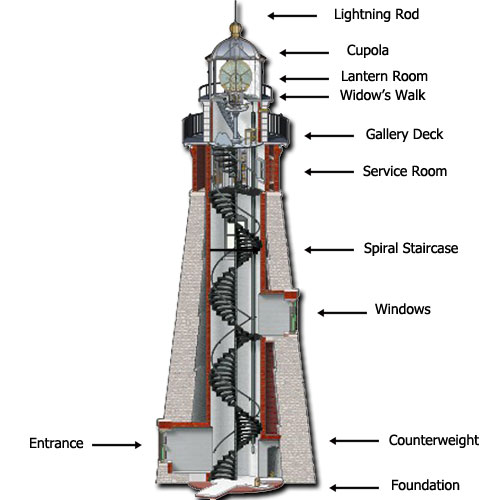Diagram
Below are details of the inner working sections of a standard lighthouse.
Some are of different shapes and sizes, but the basic principle is the same. At the bottom of this page is more information on each part.
Here is a closer view of the top section

Lightning Rod: A lightning rod is attached to a thick copper wire that runs from the top of the lighthouses down to the ground. When lightning strikes the tower, it enters through the lightning rod, travels down the wire, and goes into the ground where it can cause less damage.
Cupola: The cupola is the roof of the lantern room. Because temperatures inside the lantern room can often soar well above 110 degrees, a metal ball at the top of the cupola provides ventilation and allows the heat to escape.
Lantern Room: The lantern room is the most important room in a lighthouse because that is where the lighthouse beacon (or light) is located. The walls of the lantern room are made of glass so the light can be seen at night.
Widow’s Walk: Named after the wives of sailors who watch for the return of their husband’s ship from the top of their house, the widow’s walk is a narrow platform that provides access to the outside of the lantern room.
Gallery Deck: The gallery deck is a platform that circles the tower just below the lantern room. You can access the gallery deck from the service room through a heavy iron door. Lighthouse keepers would watch the weather and scan the horizon for approaching ships from the gallery deck.
Service Room: The service room is the room just below the lantern room where keepers would store cleaning equipment, spare parts for the beacon, and tools for working on the lighthouse.
Watch Room: The watch room is where keepers kept their log. A log is a kind of journal that keepers wrote brief descriptions of daily events, weather conditions, and notes in. Additional items used by keepers while on watch or while working at the top of the lighthouse were stored in this room as well.
Windows: Most lighthouses had windows to cool the tower and provide light.
Spiral Staircase: Most lighthouses have a long circular staircase leading from the bottom of the tower to the top. Landings are located about every 15 feet.
Counterweight: Before electricity, lighthouse beacons were turned using a system of gears powered by weights that hung down the center of the tower. The counterweight well would catch any weights that broke loose.
Entrance: Every lighthouse has a door leading into it.
Foundation: A lighthouse’s foundation keeps it from falling over.


